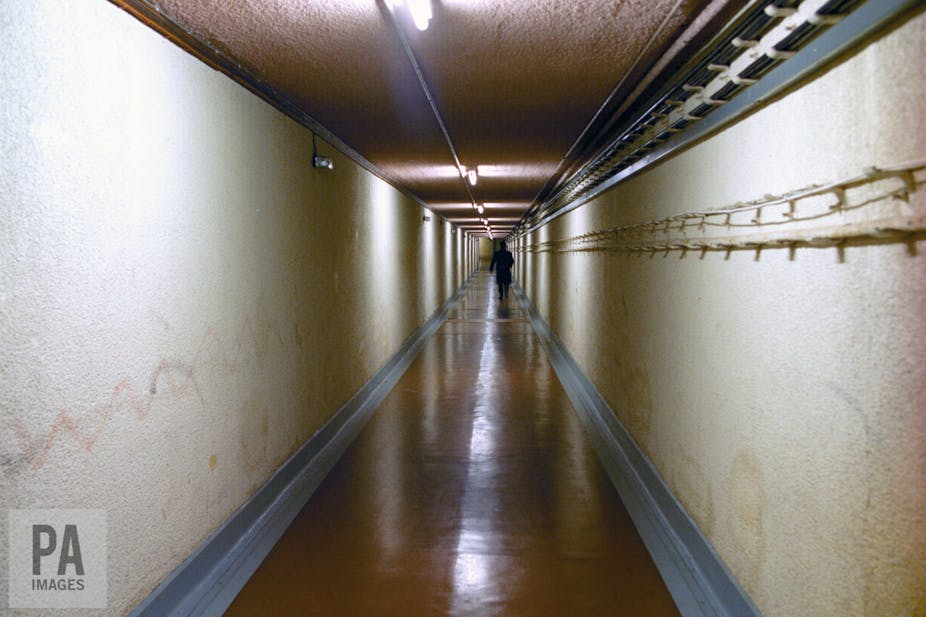Everyone needs a hobby, and mine is as good as any: I’m insatiably curious about the residual architecture of the Cold War. And so I routinely find myself leaning down to inspect a rusty hatch that leads down into the depths of the earth, almost hidden amid crumbling concrete shrouded by ivy.
Old nuclear bunkers that haven’t been repurposed normally have an eerie, abandoned feel. They are largely neglected and invisible to all except those who seek them out. As the history of British civil defence is slowly forgotten, we have literally attempted to bury the physical traces of our old fears of the Eastern Bloc.

But now, a quarter-century after the Cold War ended, we’re worrying about new nuclear threats. On January 25 2017, two Democratic congressmen introduced a bill, the Restricting First Use of Nuclear Weapons Act 2017. Should it be successful, the bill would prevent the US president (whether Donald Trump or any of his successors) from inciting any USA nuclear detonation, without agreement of declaration of war by Congress.
This is the first time that a president’s nuclear autonomy has been challenged, and possibly reflects concerns about Trump’s temperament rather than long-sightedness. Nonetheless, the bill’s timing was apt: the day after it was introduced, the Bulletin of the Atomic Scientists announced that the Doomsday Clock for nuclear war is now another 30 seconds closer to midnight.
Perhaps it’s time to resurrect our nuclear bunker architecture and to re-establish our old civil defence drills. So, when did the original idea of civil defence arise, and was it effective?
Living in fear
After the first successful test of a hydrogen bomb with an unforetold capacity for destruction in 1952, a new and stark reality faced civil defence planners. It was realised that mass protection was no longer a feasible possibility.
While it is easy to become nostalgic about the idea of somewhere safe, many of the bunkers dotted about the UK, US, and Europe during the Cold War were designed to preserve the nation-state rather than its citizens. The recessional post-war UK decided it could not afford to build mass public shelters. Instead, public civil defence advice created a new “citizen’s architecture ” of sandbags, doors removed from hinges, and fallout protection “walls” made of suitcases stuffed with books.

While the more ambitious architecture of protection was supposedly civilian, it was actually reserved for the elite – as far as the British government was concerned, “survival” meant the survival of the state rather than the people. The UK’s hundreds of buildings, bunkers and monitoring posts, some of which exist to this day, aren’t relics of civil protection, but monuments to government policies of control, deterrence and economic restraint.
Derelict and decommissioned
As abandoned facilities quietly decay, they often fall into dereliction, and the materials they’re constructed from present contamination risks. Some surviving bunkers have been repurposed as emergency control centres, which house defence control centres equipped to respond to a national emergency. This seems like an apt use for local government bunkers, since emergency planning originated with civil defence legislation. However, these bunkers’ filtration systems are switched off.
Occasionally, bunkers are sold for redevelopment into homes or museums. The only nuclear bunker in Northern Ireland was put on the market for just £575,000.
Elsewhere in Europe, bunker architecture has become a part of the landscape. The German countryside is dotted with various facilities informally open for exploration. In Albania and Romania, shelters have been reused as shops, guesthouses – even chicken coops.
Informal bunker visitors aren’t always respectful – and abandoned Cold War architecture is at risk of trespass and deliberate vandalism. Some sites have been back-filled with soil or chalk to keep trespassers out. At Beachy Head, former site of an early warning radar system, there is little evidence now that a bunker was ever there at all – unsuspecting tourists walk across it unaware of the significance of the ground beneath their feet.

In the event of a nuclear attack today, these crumbling legacy pieces would not help us in any way. Both nuclear defence and resilience technologies have undergone considerable development during the past couple of decades and the facilities that would have once protected us are now redundant.
As in the 1950s, most people cannot reasonably expect to survive a nuclear attack. Instead, we are seeing the rise of the “bourgeois bunker”: high-tech, luxurious, expensive and private bunkers are being developed by firms in the USA, to protect concerned and wealthy Silicon Valley survivalists. It seems that as ever, only the moneyed, connected and powerful are entitled to outlive a nuclear catastrophe.
Meanwhile, those survivalists who can’t afford decadent bunkers are developing their wilderness skills and hoping for the best. In these geopolitically interesting (read: frightening) times, it’s difficult to discern either the true level of risk or the safest place to be. But with most of our Cold War infrastructure derelict or beyond use, our options are fewer than we might realise.
Dr Jacquelyn Arnold also contributed to this piece. She is an expert in Cold War studies and makes significant academic contributions as a collaborator with Nuclear Families UK at the University of Southampton.

